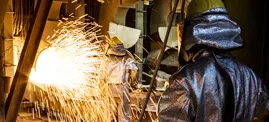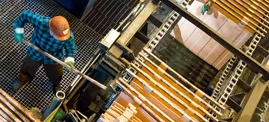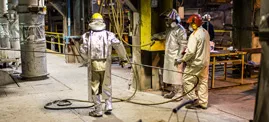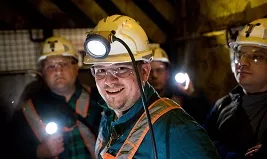General Information
The Głogów – Głęboki Przemysłowy (GG-P) mining area is adjacent to the southern limits of the mining areas currently operated by the Polkowice-Sieroszowice and Rudna mines. The investment project is 100% owned by KGHM. The recoverable resources of copper ore are estimated at nearly 227 million tonnes, with an average copper content of 2.48%, which represents approx. 1/5 of the copper resources and 1/4 of the silver resources in all KGHM licence areas in Poland. The technical infrastructure of the Rudna and Polkowice-Sieroszowice mines is used to access and extract the deposit.
The Głogów Głęboki – Przemysłowy deposit, in comparison to the presently used copper ore deposits, is characterised by a large depth of deposition. The maximum depth of the deposit reaches 1385 m.
Geological exploration of the deposit indicates a much lower degree of tectonic displacement (faults) in relation to the areas already in operation, whereas the initial rock temperature and the possibility of observing gas events are higher. In Głogów Głęboki Przemysłowy, balance copper mineralisation is presented in all three main lithological types of deposit rocks: i.e. sandstone (approx. 60% of recoverable ore resources), shale (approx. 13%) and carbonate rocks (approx. 27% of recoverable ore resources).
History
The Głogów Głęboki – Przemysłowy mining area comprises, within its boundaries, part of the copper ore resources identified in the 1970s and 1980s in the identification categories C-1 and C-2, contained in the earlier deposit documentation of Retków - Ścinawa, Głogów and Bytom Odrzański.
The distinction of the Głogów Głęboki – Przemysłowy area was preceded by a detailed technical and economic analysis, which allowed the separated copper ore resources from this deposit to be recognised as meeting the criteria of recoverability.
The first entry into the GG-P mining area with preparatory and exploratory workings took place in June 2005 and was made by Rudna mine staff.
As part of the works carried out in the Głogów Głęboki – Przemysłowy area, the sinking of the GG-1 shaft, expansion of the central air-conditioning system as well as construction and fitting of primary mining workings are underway.
The construction of the new GG-1 shaft is being carried out in stages and will be completed in the near future. At present, it will be the deepest of the 31 shafts existing in the Copper Belt, with a target depth of 1351 m and a diameter of 7.5 m.
Production
According to estimates, in the years 2028-2035 – the peak period of mining of the Głogów Głęboki – Przemysłowy deposit – output from this area will amount to 10-11 million tonnes of ore and 200-220 thousand tonnes of electrolytic copper annually. This will allow KGHM to maintain the planned level of ore production from domestic deposits for the next 20-30 years.





